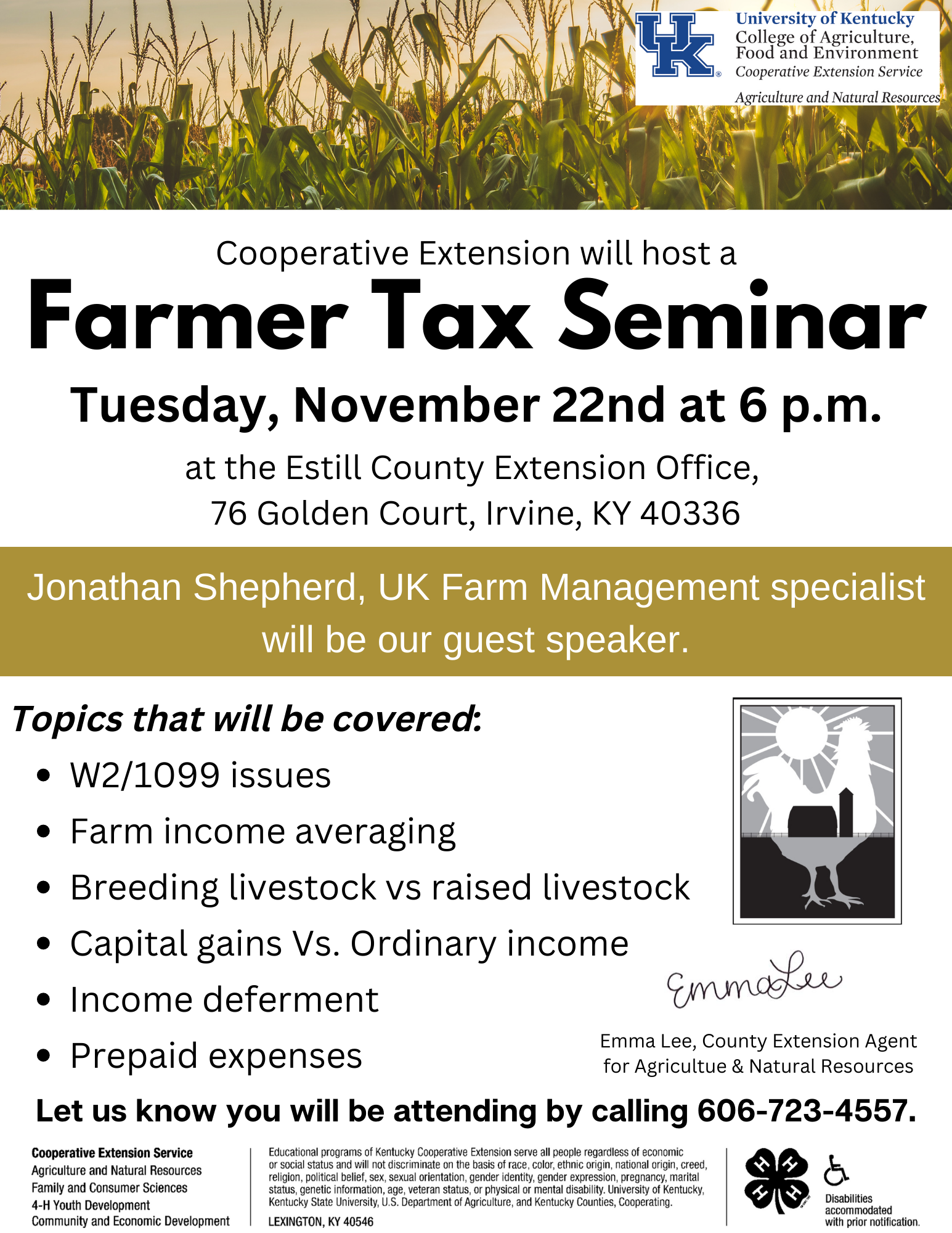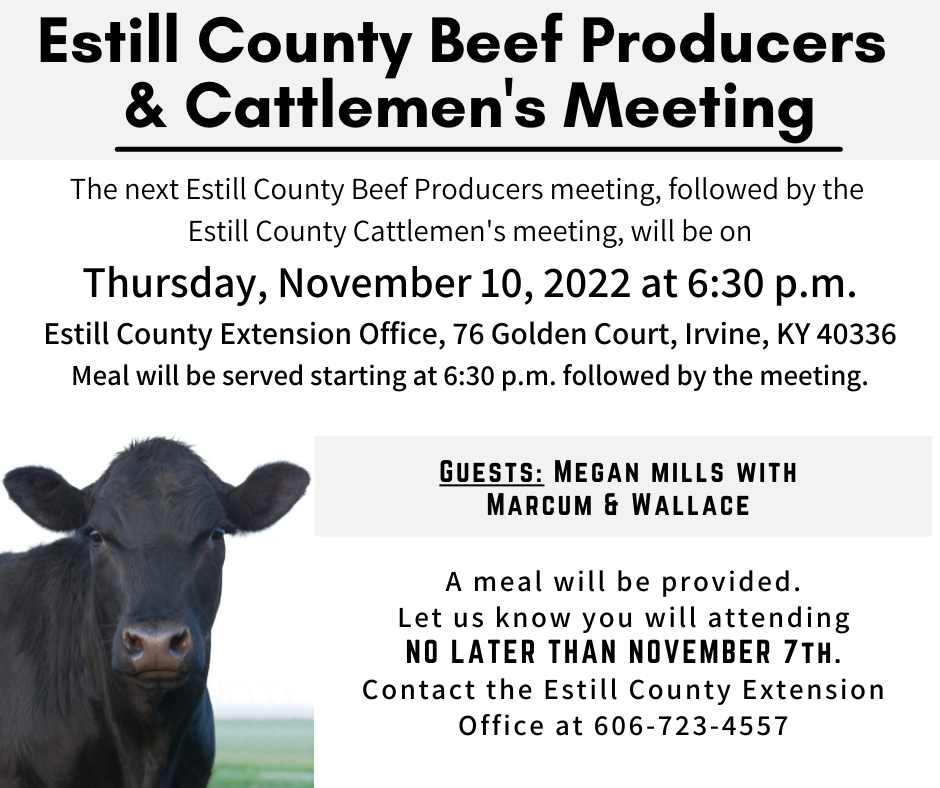Estill County Farm Scoop November 2022
November Edition
Agriculture & Natural ResourcesView Newsletter
Share this Newsletter
Additional Newsletters
Preview This Newsletter
Estill County Farm Scoop – Agriculture & Natural Resources November 2022 Newsletter
Greetings from the ANR Agent, Emma Lee –
Happy November everyone! As winter approaches, it is time to start working on sanitation in gardens and fruit orchards. Cleaning up will not only make it look nicer, but it will prevent pests and diseases from overwintering. This will help lower the pest population when spring comes around.
Also, it is that time of year to start bringing your houseplants back indoors, so they are safe from the lowering temperatures.
There will be a Farmer Tax Seminar at the Estill County Extension Office on Tuesday, November 22 at 6 p.m. Jonathan Shepherd, UK Farm Management Specialist will be our guest speaker. He will talk about the following tax topics that will help you in the upcoming months to prepare for tax season:
· W2/1099 Issues
· Farm income averaging
· Breeding Livestock vs. Raised Livestock
· Capital Gains vs. Ordinary Income
· Income Deferment
· Prepaid Expenses
If you would like to attend, please call the office at 606-723-4557 to sign up so we have the appropriate amount of materials.
The Estill County Beef Producers and Cattlemen’s will hold their next monthly meeting on Thursday, November 10. Meal will be at 6:30 p.m. followed by the meeting. This month’s guest will be Megan Mills with Marcum & Wallace. We will need a count on those who will be eating, so please call the Extension office to sign up no later than November 7th.
As always, if you have any questions, feel free to contact me by calling the office or emailing me at emma.lee@uky.edu.

Free RFID tags available for Kentucky Cattle Producers
The Kentucky Department of Agriculture is cooperating with USDA on improving the traceability of US livestock moving interstate when animal disease events take place. Currently, all cattle 18 months or older sold at a Kentucky approved livestock market OR moving interstate must be identified to the farm of origin.
Under the proposed rule, unless specifically exempted, livestock moved interstate would have to be officially identified and accompanied by a certificate of veterinary inspection or other documentation, such as ownership statements or brand certificates. The ADT rule encourages the use of low-cost technology and specifies approved forms of official identification for each species, such as RFID ear tags for cattle.
USDA proposes that this will become a national requirement by January 1, 2023. The Kentucky State Veterinarian Office is using part of our USDA grant and allotted RFID tags to strengthen the Animal Disease Traceability framework within our state. With this, we are now providing cattle producers with free RFID tags for use in replacement/breeding females and bulls.
In order to receive these tags it is required that a producer be assigned a national premise ID number. You can obtain your premise ID number by contacting me directly, or calling the State Veterinarian’s Office where one of our staff members will assist you. Once the producer receives their tags it will be the producer’s responsibility to report back to the OSV office when tags are placed in the animals. Prior to sending more tags, the “Tags Applied” form MUST be filled out with the previous tags listed accordingly. Once this is completed and received by the Office of the State Vet additional tags can be issued to the producer.
If you would like any additional information regarding the free RFID tag program, please contact Brandie Senter or Dr. Beth Johnson with your questions or concerns.
Dr. Beth Johnson, Director of Animal Health, KDA/OSV
Bethc.johnson@ky.gov (502)545-6373
Brandie Senter, Animal Disease Traceability Program Coordinator
Brandie.Senter@ky.gov (502) 782-5903 (502)229-0862
UK to host Crop Pest Management webinar series
By: Haley Simpkins, Lexington, Ky.
Beginning Nov. 8, the University of Kentucky College of Agriculture, Food and Environment will host a series of five webinars covering field crop protection. Hosted through the Southern Integrated Pest Management Center, the webinars will feature UK extension specialists discussing weed science, plant pathology and entomology.
“These webinars provide the latest grain crop pest management research findings in a convenient and accessible format that is open to everyone,” said Kiersten Wise, webinar presenter and extension plant pathologist. “The presenters are looking forward to providing updates on new or emerging pest management topics and making sure everyone in the agriculture industry has the latest information as they plan for 2023.”
The Tuesday morning webinars will take place via Zoom at 10 a.m. EST/ 9 a.m. CST, and preregistration is required for each webinar. The webinars are open to agriculture and natural resource extension agents as well as agriculture professionals, whether they reside or work in Kentucky or outside the state.
Details and links for preregistration are as follows:
· Nov. 8 - Weed Control Lessons Learned From the 2022 Crop Season with J.D. Green, weed scientist https://zoom.us/webinar/register/WN_4JQovXYvR76AZXp_tSmBwg
· Nov. 15 - Managing Important Soilborne Diseases of Soybean in Kentucky with Carl Bradley, extension plant pathologist https://zoom.us/webinar/register/WN_t6D6toO8Sh2BhyoD3iw1HQ
· Nov. 22 - Implementing Defensive Shifts Against Problematic Kentucky Weeds with Travis Legleiter, weed scientist https://zoom.us/webinar/register/WN_QnugWPJJQUynBXDf4io9zg
· Dec. 6 - Corn Disease Management Questions Asked in 2022 with Kiersten A. Wise, extension plant pathologist https://zoom.us/webinar/register/WN_KwibLTsHQY6oJjiKzURCEQ
· Dec. 13 - Entomological Studies in Corn and Soybeans Under Difficult Circumstances (Covid, a Tornado and Drought) in 2022 with Raul Villanueva, extension entomologist https://zoom.us/webinar/register/WN_3KVwBMYKQYKnxzW1K-A0-g
Participants may receive one hour per webinar in continuing education units for Certified Crop Advisers. Pesticide applicators can receive one specific continuing education unit in categories 1A and 10 per webinar. Pesticide applicators will receive December webinar credits in January 2023 that will not count toward the 2022 certification deadline. Category 12 no longer requires certification testing or CEUs.
For more information, questions or registration help, contact Jason Travis, UK agricultural extension associate, at 859-562 -2569 or email jason.travis@uky.edu.

Autumn Winds
Source: Jane Marie Wix, NWS Jackson, KY
“Those that can bend with the wind will weather the storm.” -Unknown.
You could feel the breeze beginning to pick up as autumn progresses. In fact, winds increase across a large portion of the United States during the autumn months. To our north, in the Great Lakes region, strong winds lead to dangerous lake conditions known as the “Gales of November”. But why does the wind seem to get stronger when the temperature drops? According to meteorologist John Wheeler of WDAY television in Fargo, during the autumn, winter, and spring, the absence of sunlight in the higher latitudes makes it extremely cold, while the tropics remain warm and…well…tropical. This enhanced temperature gradient across the United States leads to a stronger Jet Stream and larger air pressure differences between weather systems, both of which lead to more air movement in general.
These more noticeable differences in air masses during the autumn months may also lead to stronger frontal passages and storm systems. Multiple strong wind events during the autumn months have caused damage, injuries, and even deaths across the Commonwealth. While weather reporting stations, such as the Kentucky Mesonet, measure wind speeds and gusts accurately, you can also estimate the wind speeds you are encountering by using the Beaufort Wind Scale.

Given this scale, it is also understandable why the National Weather Service sets a threshold of 58 mph (50 kts) for severe thunderstorm warnings, as this is the speed at which damage is most likely to occur.
You can help prepare for the strong winds ahead and hopefully prevent damage to your property, or worse, by taking the following steps:
· Trim tree branches away from your house and power lines.
· Secure loose gutters and shutters.
· Identify an interior room of your house, such as a basement or interior bathroom, that you can take shelter in during high wind warnings.
· If you live in a mobile home, identify a sturdy building you can go to if NWS issues a high wind or severe thunderstorm warning.
· Charge batteries of all essential items such as cell phones and booster packs, weather radios and power tools such as a reciprocating saw, which you might need to clear debris.
· Update your emergency kit and be sure to include enough food and water to last for 3 days for each person in your home. Acquire flashlights, spare batteries, and generator fuel if you use backup generators.
· Make a list of items outside your home you will need to tie down or put away so that they don't blow away or fly through a window. When NWS issues a high wind or severe thunderstorm watch, immediately secure these items to avoid damage or injury.
Plate it up! Kentucky Proud Fall Harvest Salad Recipe
Ingredients:
- 5 cups torn leaf lettuce
- 2 1/2 cups spinach leaves
- 1 medium red apple, chopped
- 1 medium pear, chopped
- 4 teaspoons lemon juice
- 1/4 cup dried cranberries
- 1/4 cup feta cheese crumbles
- 1/2 cup chopped walnuts
Dressing:
- 2 1/2 tablespoons olive oil
- 2 tablespoons balsamic vinegar
- 1 1/2 teaspoons Dijon mustard
- 2 teaspoons Kentucky honey
- 1/2 teaspoon salt
Combine leaf lettuce and spinach leaves in a large salad bowl. Mix apples and pears with lemon juice in a small bowl and add to lettuce mixture. Prepare dressing by whisking together the olive oil, balsamic vinegar, Dijon mustard, honey and salt; pour over lettuce mixture and toss to coat. Sprinkle salad with cranberries, feta cheese and walnuts. Serve immediately.
Yield: 8, 1 cup servings
Nutritional Analysis: 130 calories, 9 grams fat, 1.5 grams saturated fat, 240 mg sodium, 12 grams carbohydrates, 3 grams fiber, 7 grams sugar, 3 grams protein

